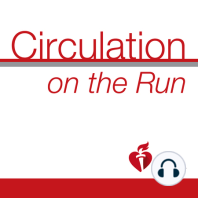18 min listen
Circulation May 14, 2019 Issue
ratings:
Length:
23 minutes
Released:
May 13, 2019
Format:
Podcast episode
Description
Dr Carolyn Lam: Welcome to Circulation on the Run, your weekly podcast summary and backstage pass to the journal and its editors. I'm Dr Carolyn Lam, Associate Editor from the National Heart Center and Duke National University of Singapore. Dr Greg Hundley: And I'm Greg Hundley, Associate Editor of Circulation from the Pauley Heart Center at VCU Health in Richmond, Virginia. Dr Carolyn Lam: Are NOACs, or non-vitamin K antagonist oral anticoagulants, safe and efficacious in patients with extremely high or very low body weight? Very interesting paper and discussion coming right up. Greg, I hear that you've got a couple of papers you'd like to highlight first. Dr Greg Hundley: You bet, Carolyn. My two papers today both focus on ventricular dysrhythmia. The first one, from Yuki Komatsu from Tsukuba, Japan, researches the efficacy of catheter ablation of refractory ventricular fibrillation storm after myocardial infarction. VF storm attributed to focally triggered VF after MI is recognized as a distinctive, lethal, arrhythmogenic syndrome that differs from scar mediated monomorphic VT. This study investigated the acute and long-term outcomes of catheter ablation for the treatment of last resort in a large series of consecutive patients with post-MI VF storm refractory to medical therapies. In the study, investigators enrolled 110 patients averaging about sixty-five years in age. Ninety-two were men, and their average ejection fraction was approximately 31%. VF storm occurred in the acute phase of MI, about four and a half days after MI-onset, during the index hospitalization in about 39% of the patients. It was sub-acute (that is greater than 1 week later) in 44% of patients. It was remote (greater than 6 months later) in 17% of patients. And the focal triggers were found to originate from the scar border zone in 80% of the individuals. Dr Carolyn Lam: And what did the study show? Dr Greg Hundley: So Carolyn, during in hospital stay after ablation, VF storm subsided in 84% of patients and overall, 27% of in-hospital deaths occurred. The duration from the VF occurrence to the ablation procedure was associated with in-hospital mortality, with a P-value of 0.008. During follow-up after discharge from the hospital, only one patient developed recurrent VF storm. Of note though, 36% of the patients died, with a median survival of 2.2 years. And the long-term mortality was associated with a low EF (less than 30%), New York Heart Association class greater than 3 Heart Failure, a history of atrial fibrillation or chronic kidney disease. So in summary Carolyn, the results of this study show that in patients with MI presenting with focally-triggered VF storm, catheter ablation of the culprit triggers is life-saving and appears to be associated with short and long-term freedom from recurrent VF storm. The overall mortality for these patients is associated with the severity of their underlying cardiovascular disease, and those associated co-morbidities. Now my next paper is from one of our associate editors, Sami Viskin from Tel Aviv University. He's looking at a new form of polymorphic VT. Now as we think about polymorphic VT, I always think about the long QT interval syndromes associated with Torsades de Pointes. We have specific management strategies for those long QT syndromes, but Carolyn, there's a second category of polymorphic VT that's not related to QT prolongation. This second category involves patients without structural heart disease, who have genetic disorders like Brugada or patients that may have experienced hypothermia. There is also a third category of individuals with structural heart disease, during acute ST elevation MI. What Sami has discovered is the
Released:
May 13, 2019
Format:
Podcast episode
Titles in the series (100)
Circulation November 28, 2017 Issue: Circulation Weekly: Your Weekly Summary & Backstage Pass To The Journal by Circulation on the Run
